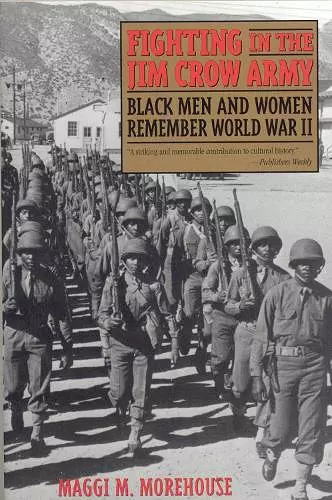Fighting in the Jim Crow Army
Black Men and Women Remember World War II
Format:Paperback
Publisher:Rowman & Littlefield
Published:28th Dec '06
Currently unavailable, and unfortunately no date known when it will be back

Fighting in the Jim Crow Army is filled with first-hand accounts of everyday life in 1940s America. The soldiers of the 92nd and 93rd Infantry Divisions speak of segregation in the military and racial attitudes in army facilities stateside and abroad. The individual battles of black soldiers reveal a compelling tale of discrimination, triumph, resistance, and camaraderie. What emerges from the multitude of voices is a complex and powerful story of individuals who served their country and subsequently made demands to be recognized as full-fledged citizens. Morehouse, whose father served in the 93rd Infantry Division, has built a rich historical account around personal interviews and correspondence with soldiers, National Archive documents, and military archive materials. Augmented with historical and recent photographs, Fighting in the Jim Crow Army combines individual recollections with official histories to form a vivid picture of life in the segregated Army. In the historiography of World War II very little has emerged from the perspective of the black foot soldier. Morehouse allows the participants to tell the tale of the watershed event of their participation in World War II as well as the ongoing black freedom struggle.
This is an important, largely untold story about the lives of black men and women who fought to make the world free for democracy when they themselves were not free. * Cincinnati Enquirer *
Just as we had begun to think that the major stories of African American history had been told, along comes Maggi M. Morehouse with a moving account of black soldiers during World War II. Her report is the all too familiar one of segregation during training at home and discrimination on the battlefields in Europe and the Pacific. Yet the tale comes close to having a happy ending when veterans who had had an opportunity to see the world outside of their segregated communities were then enabled to get an education under the GI Bill of Rights. The result was a generation of young people, many of whom were able to move into the middle class and to join in the struggle for equal rights during the l950s–60s. Told largely in the words of the soldiers themselves who were interviewed extensively by Ms. Morehouse, Fighting In the Jim Crow Army is an engrossing account, skillfully reported. -- Dorothy Sterling, author of We Are Your Sisters and The Making of an Afro-American
An anecdotal history of the African-American members of the 'Greatest Generation.' . . . Morehouse enlivens her text with many narratives told by the veterans themselves. * Kirkus *
Morehouse organizes threads from many individual stories into coherent descriptions of contemporary culture and of conditions in the segregated black divisions, conveying all of the soldiers' frustration, anger, and humiliation from discrimination and the joy of their victories. . . . A striking and memorable contribution to cultural history. * Publishers Weekly *
One result of racism is that much historical truth is seldom told. Using 50 in-depth interviews with black veterans, Morehouse tells much truth about the 650,000 black men who served in segregated army units during WW II. All collections. * CHOICE *
Illustrates the crucial link between the Second World War and what has sometimes been referred to as the Second Civil War, the black freedom struggle of the 1960s. For what we learn in these pages is that a generation of black men, hundreds of thousands of them, began the most important struggle of our time for equal protection before the laws and for simple human dignity. -- Maurice Isserman, author of America Divided: The Civil War of the 1960s (from the foreword)
Maggi Morehouse's work adds a vibrant chapter to the annals of the war—a chapter the history books have long neglected. * Tampa Tribune and Times *
An important corrective to histories that ignore the racism that permeated the armed forces. * The Dallas Morning News *
The strength of Jim Crow lies in the skillful sandwiching of research data between first person statements of the principals. Together they brilliantly portray the past workings of a nation then divided and exceptionally underline the fact that abilities and capabilities cannot be measured by skin color. * Journal of Political and Military Sociology *
Fighting in the Jim Crow Army helps readers discover, for those who forgot, when the first steps were made along the long road to racial equality. The book is an important source for those teaching African-American history, World War II (particularly if the instructor seeks to offer a component concerning race relations), and ethnic studies. * Teaching History: A Journal of Methods *
A fascinating collection of personal accounts reminding us of the unfortunate mistreatment that African Americans once routinely endured. * Post Library *
ISBN: 9780742548053
Dimensions: 228mm x 145mm x 17mm
Weight: 349g
272 pages